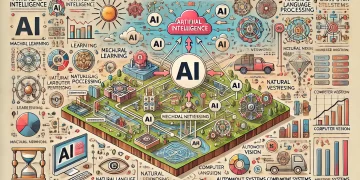Cybersecurity threats are evolving rapidly, making it increasingly difficult for traditional security measures to keep up. Artificial Intelligence (AI) is playing a crucial role in strengthening cybersecurity by enhancing threat detection, automating incident response, and mitigating risks in real time. AI-powered cybersecurity solutions leverage machine learning, deep learning, and behavioral analytics to detect, prevent, and respond to cyber threats more effectively. This article explores various AI use cases in cybersecurity and how they are transforming digital security strategies.
1. AI-Powered Threat Detection and Prevention
AI-driven threat detection systems analyze vast amounts of network traffic and identify anomalies that may indicate cyberattacks. Machine learning algorithms detect suspicious behavior patterns and automatically flag potential threats before they cause harm. AI-based security information and event management (SIEM) systems enhance real-time monitoring and risk assessment.
2. Automated Incident Response
AI-driven cybersecurity tools automate incident response by identifying, containing, and mitigating cyber threats. Security orchestration, automation, and response (SOAR) platforms use AI to accelerate response times, reducing the impact of security breaches. AI-enabled automation minimizes human intervention, improving efficiency and accuracy in handling security incidents.
3. Behavioral Analytics for Insider Threat Detection
AI analyzes user behavior patterns to detect anomalies that may indicate insider threats. By establishing baseline behavioral profiles, AI-driven systems can flag deviations that could signify unauthorized access, credential misuse, or potential data breaches. AI enhances security by identifying risky activities within organizations before they escalate into major security incidents.
4. AI in Phishing and Email Security
Phishing attacks remain one of the most common cybersecurity threats. AI-powered email security solutions analyze email content, sender behavior, and metadata to detect phishing attempts in real-time. Natural Language Processing (NLP) and machine learning models identify suspicious emails, preventing users from falling victim to social engineering attacks.
5. AI for Malware Detection and Analysis
Traditional signature-based antivirus solutions struggle to detect sophisticated malware threats. AI-powered endpoint security systems use machine learning algorithms to analyze file behavior, detect zero-day malware, and prevent malicious code execution. AI-driven sandboxing solutions analyze suspicious files in isolated environments to determine their threat level before they can infect a system.
6. AI in Fraud Detection and Financial Security
Financial institutions use AI-driven fraud detection systems to monitor transactions, detect fraudulent activities, and prevent unauthorized access. AI models analyze transaction patterns, detect anomalies, and flag suspicious activities in real-time, helping banks and financial organizations combat cyber fraud effectively.
7. AI in Identity and Access Management (IAM)
AI enhances identity and access management by continuously monitoring user authentication and access patterns. AI-driven multi-factor authentication (MFA) systems use biometric recognition, behavior-based authentication, and adaptive access controls to prevent unauthorized access to critical systems.
8. AI in Network Security and Intrusion Detection
AI-powered network security solutions analyze network traffic patterns to identify potential threats and intrusions. Intrusion detection systems (IDS) and intrusion prevention systems (IPS) use AI to detect unauthorized activities, alert security teams, and prevent cyberattacks. AI helps organizations secure their networks against advanced persistent threats (APTs) and distributed denial-of-service (DDoS) attacks.
9. AI for Cloud Security and Data Protection
As businesses migrate to cloud environments, AI-driven security tools help safeguard cloud infrastructure. AI enhances cloud security by identifying misconfigurations, preventing unauthorized data access, and ensuring compliance with security policies. AI-driven encryption and data loss prevention (DLP) solutions protect sensitive information from cyber threats.
10. AI in Threat Intelligence and Cyber Risk Management
AI-driven threat intelligence platforms analyze global cyber threat data to predict and prevent potential attacks. AI helps security analysts stay ahead of emerging threats by continuously updating threat intelligence databases. Cyber risk management tools use AI to assess vulnerabilities, prioritize risks, and recommend mitigation strategies.
Conclusion
AI is transforming cybersecurity by providing advanced threat detection, automating incident response, and improving risk management. As cyber threats become more sophisticated, AI-driven security solutions play a crucial role in protecting digital assets and ensuring business continuity. Organizations must continue to invest in AI-powered cybersecurity to stay ahead of evolving cyber risks.
References
- IBM Security. (2023). “AI-Powered Threat Detection: Enhancing Cyber Resilience.”
- McKinsey & Company. (2023). “The Role of AI in Cybersecurity Automation.”
- Gartner. (2022). “AI in Identity and Access Management: Trends and Best Practices.”
- Forbes. (2023). “How AI is Revolutionizing Fraud Detection in Financial Services.”
- Cybersecurity & Infrastructure Security Agency (CISA). (2023). “AI and Cyber Risk Management.”
- PwC. (2022). “Leveraging AI for Cloud Security and Data Protection.”




































